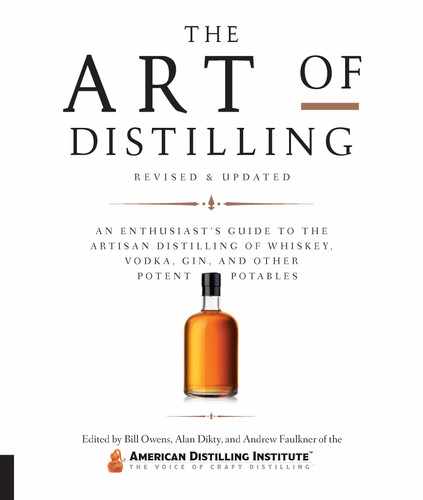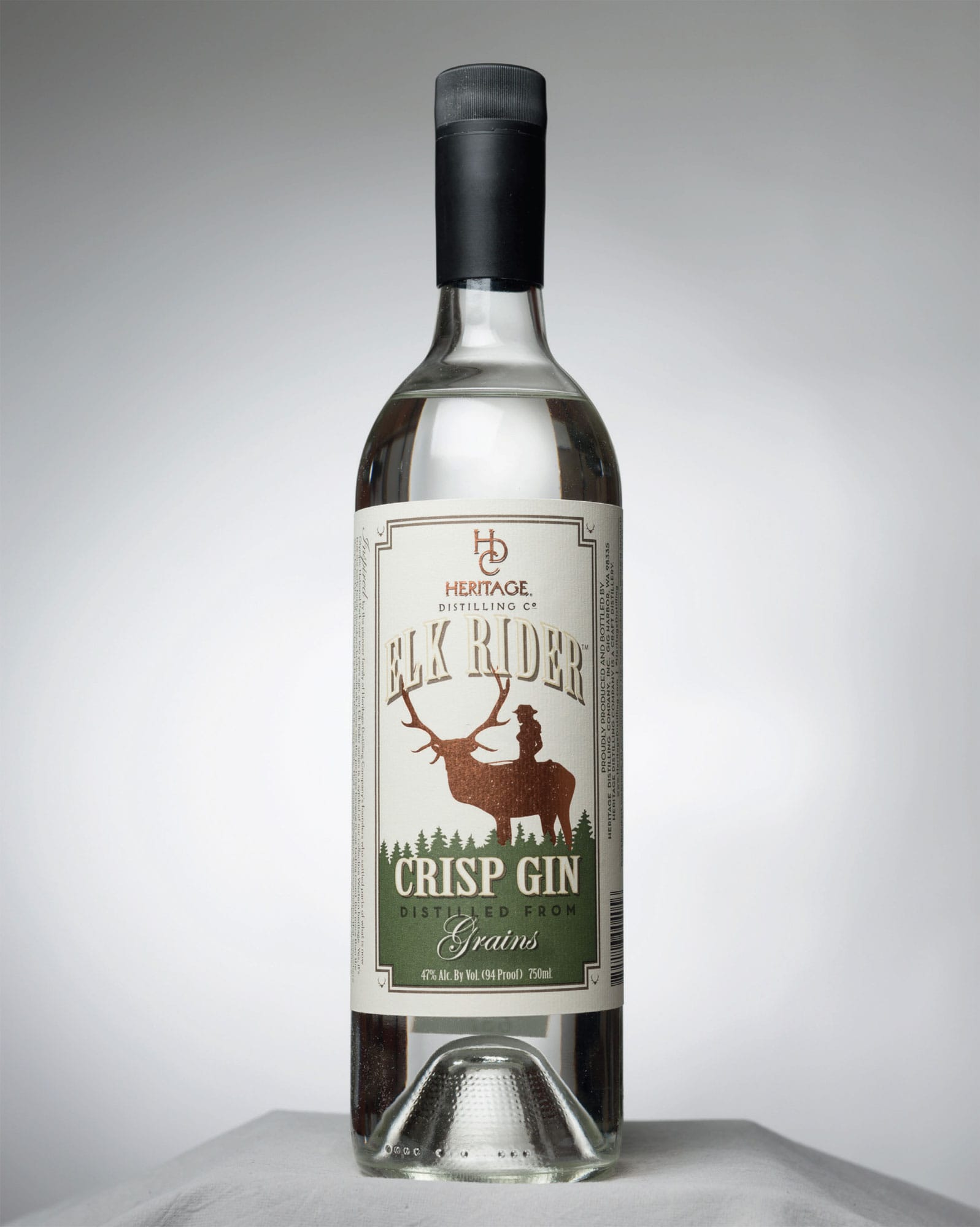Chapter 5
GIN
GIN is a juniper berry–flavored grain spirit. The word is an English shortening of Genever, the Dutch word for juniper. The origins of gin are a bit murky. In the late 1580s, a juniper-flavored spirit of some sort was found in Holland by British troops who were fighting against the Spanish in the Dutch War of Independence. They gratefully drank it to give them what they soon came to call “Dutch courage” in battle. The Dutch themselves were encouraged by their government to favor such grain spirits over imported wine and brandy by a lack of excise taxes on local drinks.
“THE PROPER UNION OF GIN AND VERMOUTH IS A GREAT AND SUDDEN GLORY; IT IS ONE OF THE HAPPIEST MARRIAGES ON EARTH, AND ONE OF THE SHORTEST LIVED.”
Bernard DeVoto, American essayist and drinks philosopher

Farallon Gin Works Gin Farallon earned a gold medal in the American Distilling Institute’s 2017 Judging of Craft Spirits.
THE HISTORY OF GIN
In the 1600s, a Dr. Franciscus de la Boë in the university town of Leiden created a juniper- and spice-flavored medicinal spirit that he promoted as a diuretic. This tonic, called Genever, soon found favor across the English Channel, first as a medicine (Samuel Pepys wrote in 1660 of curing a case of “colic” with a dose of “strong water made with juniper”) and then as a beverage.
When the Dutch Protestant William of Orange became king of England in 1689, he moved to discourage the importation of brandy from the Catholic winemaking countries by setting high tariffs. As a replacement, he promoted the production of grain spirits (“corn brandy,” as it was known at the time) by abolishing taxes and licensing fees for the manufacture of such local products as gin. History has shown that prohibition never works, but unfettered production of alcohol has its problems, too. By the 1720s, it was estimated that a quarter of the houses in London were used for the production or sale of gin. Mass drunkenness became a serious problem. The cartoonist William Hogarth’s famous depiction of such behavior in Gin Lane shows a sign above a gin shop that states, “Drunk for a penny/Dead drunk for two pence/Clean straw for Nothing.” Panicky attempts by the government to prohibit gin production, such as the Gin Act of 1736, resulted in massive illicit distilling and the cynical marketing of “medicinal” spirits with such fanciful names as Cuckold’s Comfort and My Lady’s Eye Water.
A combination of reimposed government controls, the growth of high-quality commercial gin distillers, the increasing popularity of imported rum and a general feeling of public exhaustion gradually brought this mass hysteria under control, although the problems caused by the combination of cheap gin and extreme poverty extended well into the nineteenth century. Fagin’s irritable comment to a child in the film Oliver—“Shut up and drink your gin!”—had a basis in historical fact.

Michael Lowe founded New Columbia Distillers, the oldest distillery in Washington, DC, and makers Green Hat Gin.

Gin Lane by William Hogarth
Wherever the British Empire went, English-style gins followed. In British colonies in North America, such celebrated Americans as Paul Revere and George Washington were notably fond of gin, and the Quakers were well known for their habit of drinking gin toddies after funerals.
The mid-nineteenth century ushered in a low-key rehabilitation of gin’s reputation in England. The harsh, sweetened “Old Tom” style of gin of the early 1700s slowly gave way to a new, cleaner style called dry gin. This style of gin became identified with the city of London to the extent that “London dry” became a generic term for the style, regardless of where it was actually produced.
Genteel middle-class ladies sipped their sloe gin (gin flavored with sloe berries) while consulting Mrs. Beeton’s Book of Household Management (a wildly popular Victorian cross between the Joy of Cooking and Martha Stewart lifestyle books) for gin-based mixed drink recipes. The British military, particularly the officer corps, became a hotbed of gin consumption. Hundreds of gin-based mixed drinks were invented and the mastery of their making was considered a part of a young officer’s training. The best known of these cocktails, the gin and tonic, was created as a way for Englishmen in tropical colonies to take their daily dose of quinine, a very bitter medicine, to ward off malaria. (Modern tonic water still contains quinine, though as a flavoring rather than a medicine.)
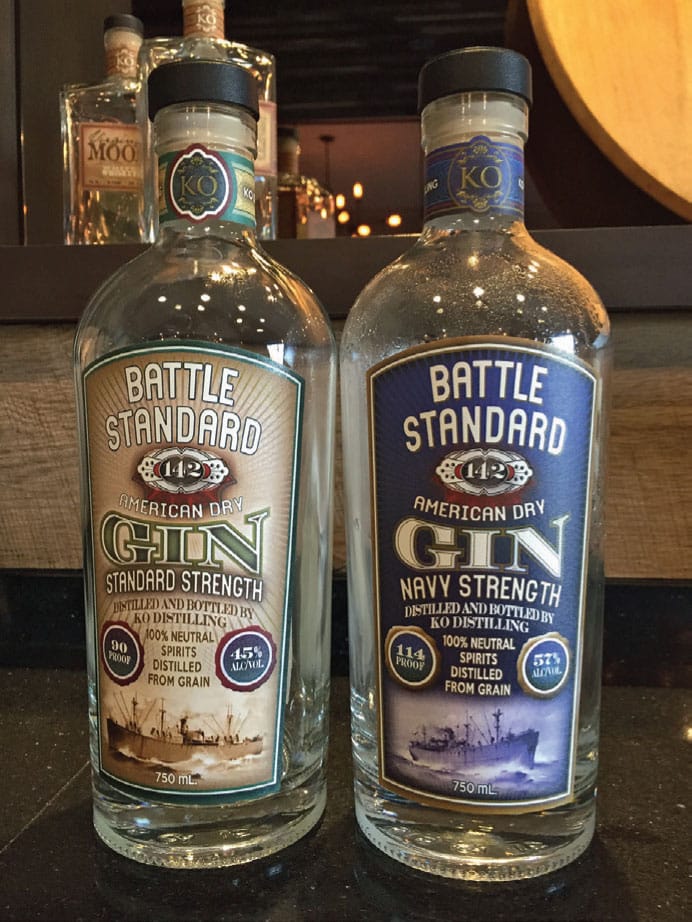
Battle Standard Gin by KO Distilling, Manassas, VA.

Bols Barrel Aged Genver by Lucas Bols, Amsterdam, Holland.
THE BASIS OF GIN
In Holland, the production of Genever was quickly integrated into the vast Dutch trading system. Rotterdam became the center of Genever distilling as distilleries opened there to take advantage of the abundance of spices that were arriving from the Dutch colonies in the East Indies (present-day Indonesia). Many of today’s leading Dutch Genever distillers can trace their origins back to the sixteenth and seventeenth centuries. Examples include such firms as Bols (founded 1575) and de Kuyper (1695).
Belgium developed its own juniper-flavored spirit, called jenever (with a j), in a manner similar to that in Holland (which controlled Belgium for a time in the early nineteenth century). The two German invasions of Belgium in World Wars I and II had a particularly hard effect on jenever producers, as the occupying Germans stripped the distilleries of their copper stills and piping to use in the production of shell casings. The present-day remaining handful of Belgian jenever distillers produce primarily for the local domestic market.

Cheeky packaging for Ableforth’s Bathtub Gin pokes fun at gin’s sketchy past while producing an award-winning Sloe Gin, formerly a genteel ladies’ drink.
Gin may have originated in Holland and developed into its most popular style in England, but its most enthusiastic modern-day consumers are to be found in Spain, which has the highest per capita consumption in the world. Production of London dry–style gin began in the 1930s, but serious consumption did not begin until the mix of gin and cola became inexplicably popular in the 1960s.
Gin and its Dutch cousin genever (jenever in Belgium) are white spirits that are flavored with juniper berries and so-called botanicals (a varied assortment of herbs and spices). The spirit base of gin is primarily grain (usually wheat or rye), which results in a light-bodied spirit. Genever is made primarily from “malt wine” (a mixture of malted barley, wheat, corn, and rye), which produces a fuller-bodied spirit similar to malt whiskey. A small number of Genevers in Holland and Belgium are distilled directly from fermented juniper berries, which produces an intensely flavored spirit.
The chief flavoring agent in both gin and genever is the highly aromatic blue-green berry of the juniper, a low-slung evergreen bush (genus Juniperus) that is commercially grown in northern Italy, Croatia, the United States, and Canada. Additional botanicals can include anise, angelica root, cinnamon, orange peel, coriander, and cassia bark. All gin and genever makers have their own secret combination of botanicals, the number of which can range from as few as four to as many as fifteen.

Gin by Corsair Artisan earned a Best of Category Gold medal at the American Distilling Institute’s 9th Annual Judging of Craft American Spirits.

Caledonia Spirits Barr Hill Gin earned a gold medal, best of category and best of class in the American Distilling Institute’s 2017 Judging of Craft Spirits.
THE DISTILLATION OF GIN
The base spirit for most non-genever style gin is initially distilled in efficient column stills. The resulting spirit is high proof, light-bodied, and clean, with a minimal amount of congeners (flavor compounds) and flavoring agents. Genever is distilled in less-efficient pot stills, which results in a lower-proof, more flavorful spirit.
Low-quality “compound” gins are made by simply mixing the base spirit with juniper and botanical extracts. Mass-market gins are produced by soaking juniper berries and botanicals in the base spirit and then redistilling the mixture.
Top-quality gin and genever are flavored in a unique manner. After one or more distillations, the base spirit is redistilled one last time. During this final distillation, the alcohol vapor wafts through a chamber in which the dried juniper berries and botanicals are suspended. The vapor gently extracts aromatic and flavoring oils and compounds from the berries and spices as it travels through the chamber on its way to the condenser. The resulting flavored spirit has a noticeable degree of complexity.

Martin Ryan Distilling Co., Portland, OR, keeps samples of every batch of Aria Gin the distillery has released. They refer back to these bottles when making a new batch.

Wild-foraged botanicals from the California coastal mountains are dried in preparation for making gin at Ventura Spirits.


Two James Distillery Barrel Reserve Old Cockney Gin.
STYLE |
DEFINITION |
HOWEVER… |
London Dry Gin |
The dominant English style of gin in the United Kingdom, former British colonies, the United States and Spain. |
It need not be truly “dry” and it lends itself well to mixing. |
Plymouth Gin |
Relatively full-bodied (compared to London dry gin). It is clear, slightly fruity, and very aromatic. |
Originally the local gin style of Plymouth, England, modern Plymouth gin is made only by one distillery in Plymouth, Coates & Co., which also controls the rights to the name Plymouth Gin. |
Old Tom Gin |
The last remaining example of the original, lightly sweetened gins that were popular in eighteenth-century England. |
Limited quantities of Old Tom–style gin are still made by a few British distillers and several American craft distillers, but it is, at best, a curiosity item. |
Genever or Hollands |
The Dutch style of gin, distilled from a malted grain mash similar to that used for whiskey. Oude (old) Genever is the original style. It is straw-hued, relatively sweet, and aromatic. Jonge (young) Genever has a drier palate and lighter body. Some Genever is aged for one to three years in oak casks. Genever tends to be lower proof than English gin (72 to 80 proof is typical). They are usually served straight up and chilled. |
The classic accompaniment to a shot of genever is a dried green herring. Genever is traditionally sold in a cylindrical stoneware crock. Genever-style gins are produced in Holland, Belgium, Germany, and the United States. |
DON’T CALL IT BARREL AGED!
With the 2008 release of Citadelle Reserve Gin from France, and Ransom Old Tom Gin from Oregon, the gin flavor spectrum swung in a new direction—barrel-aged gins. After reading historical accounts of shipping gin in past centuries using wooden casks, these producers began to experiment with the effects that exposure to wood would have on gin. The cocktail culture swallowed these spirits up with glee, and soon the rush was on. Craft distilleries—many of whom were making gin to have cash flow while waiting for whiskey to age—saw a line extension in these lightly aged spirits. The flavors range anywhere from a classic gin to a juniper-flavored whiskey, depending on what kind of cask was used and how long the spirit rested in it.
There was only one small problem: There are regulations prohibiting putting the words “barrel aged” on beverage alcohol labels. After approving a few barrel-aged gins, the U.S. government revoked some of these labels and declined further applications. This did not stop the products from coming, distillers just had to think of another term. There is an abundance of very interesting gins that are now termed; oak-finished, oak-rested, barrel-rested, reserve, cask-finished, antique,… etc. All of these terms mean one thing: that the gin was barrel aged.

Hernö Old Tom Gin earned a gold medal and best of category in the American Distilling Institute’s 2017 Judging of Craft Spirits.
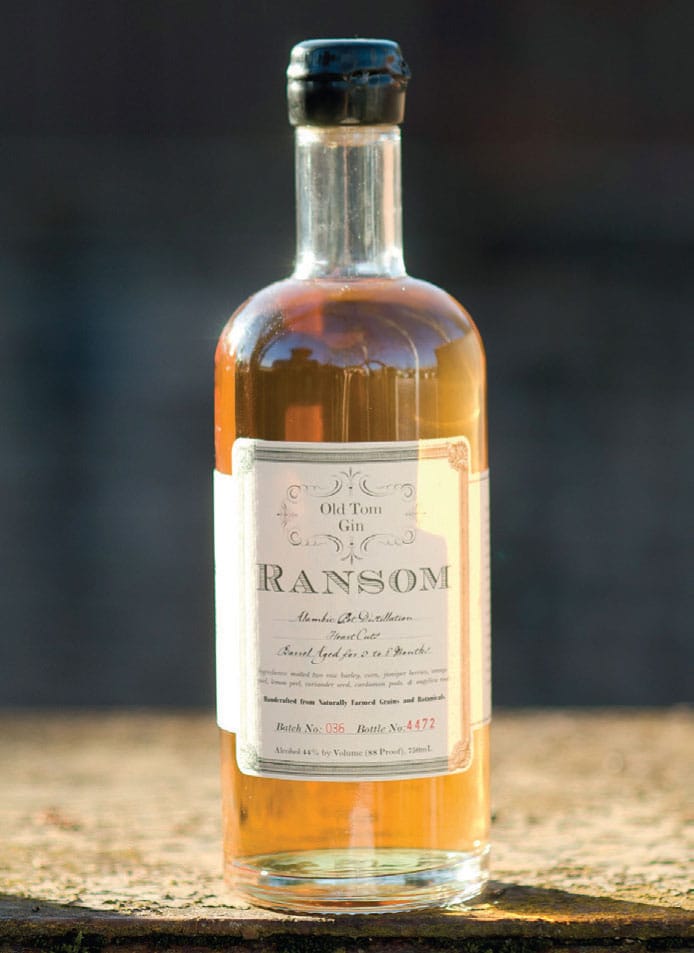
Tad Seestedt of Ransom Spirits released Ransom Old Tom Gin, which was the first of the US-made barrel-aged gins, setting of trend that has reverberated through the distilled spirits community.
GIN REGIONS
EUROPE
The United Kingdom produces mostly dry gin, primarily from column stills. British gins tend to be high proof (90° proof or 45 percent ABV) and citrus-accented from the use of dried lemon and Seville orange peels in the mix of botanicals. British gins are usually combined into mixed drinks.
Holland and Belgium produce genever, mostly from pot stills. Genevers are distilled at lower proof levels than English gins and are generally fuller in body. Many of these gins are aged for one to three years in oak casks. Some genever producers now market fruit-flavored genever, the best known being black currant. Dutch and Belgian genever are usually chilled and served neat.
Germany produces a genever-style gin called Dornkaat in the North Sea coast region of Frisia. This spirit is lighter in body and more delicate in flavor than both Dutch genever and English dry gin. German gin is usually served straight up and cold.
Spain produces a substantial amount of gin, all of it in the London dry style from column stills. Most of it is sold for mixing with cola.
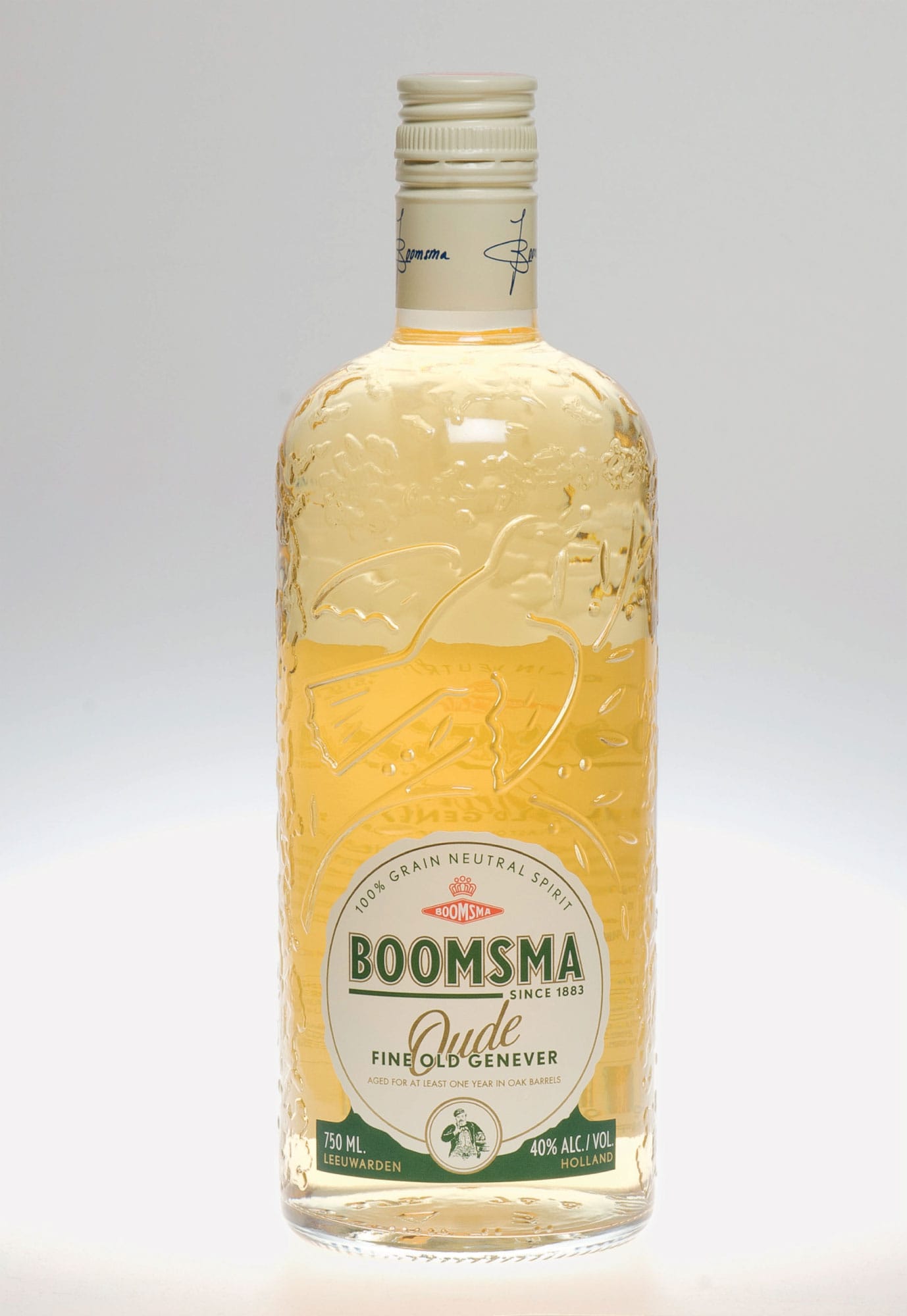
Boomsma Oude Fine Old Genever, Leeuwarden, Holland.
Elk Rider Crisp Gin by Heritage Distilling Company earned a Gold Medal, Best of Category, Best of Class, in the American Distilling Institute’s 10th Annual Judging of Craft Spirits, 2016.
NORTH AMERICA
The United States is the world’s largest gin market. London dry gin accounts for the bulk of domestic gin production, with most of it produced in column stills, although craft-distillery gin is usually made using hybrid pot stills with columns. American dry gins from the national distillers tend to be lower proof (80° proof or 40 percent ABV) and less flavorful than their English counterparts. This rule applies even to brands such as Gordon’s and Gilbey’s, which originated in England. The best-selling gin in the United States, Seagram’s Extra Dry, was originally a dry gin that was aged for three months in used whiskey barrels to give it a pale straw hue, and a distinctive smooth palate that had a hardcore fan base. The color remains, but in recent years the three month aging has been quietly discontinued.
American craft distillers, in an approach analogous to their craft-brewery counterparts with India Pale Ale, are increasingly experimenting with more exotic and assertive botanicals as their flavoring agents.
American craft distilleries have taken to gin in a major way, with such noteworthy examples as Distiller’s Gin #6 from North Shore Distillery in Lake Bluff, Illinois, and Rehorst Premium Milwaukee Gin from the Great Lakes Distillery in Milwaukee, Wisconsin.

Backbar at Jersey Spirits Distillery, Fairfield, NJ.

